PD-1 and PD-L1 Inhibitors Market Size
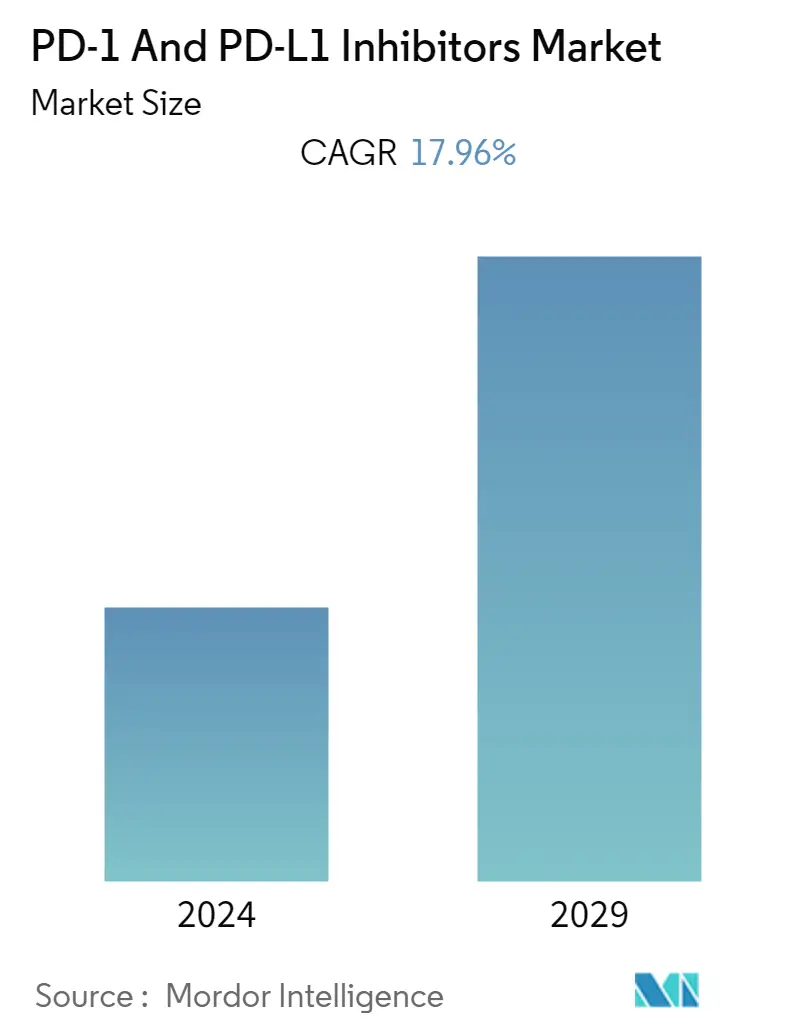
| Study Period | 2019 - 2029 |
| Base Year For Estimation | 2023 |
| CAGR | 17.96 % |
| Fastest Growing Market | Asia Pacific |
| Largest Market | North America |
| Market Concentration | High |
Major Players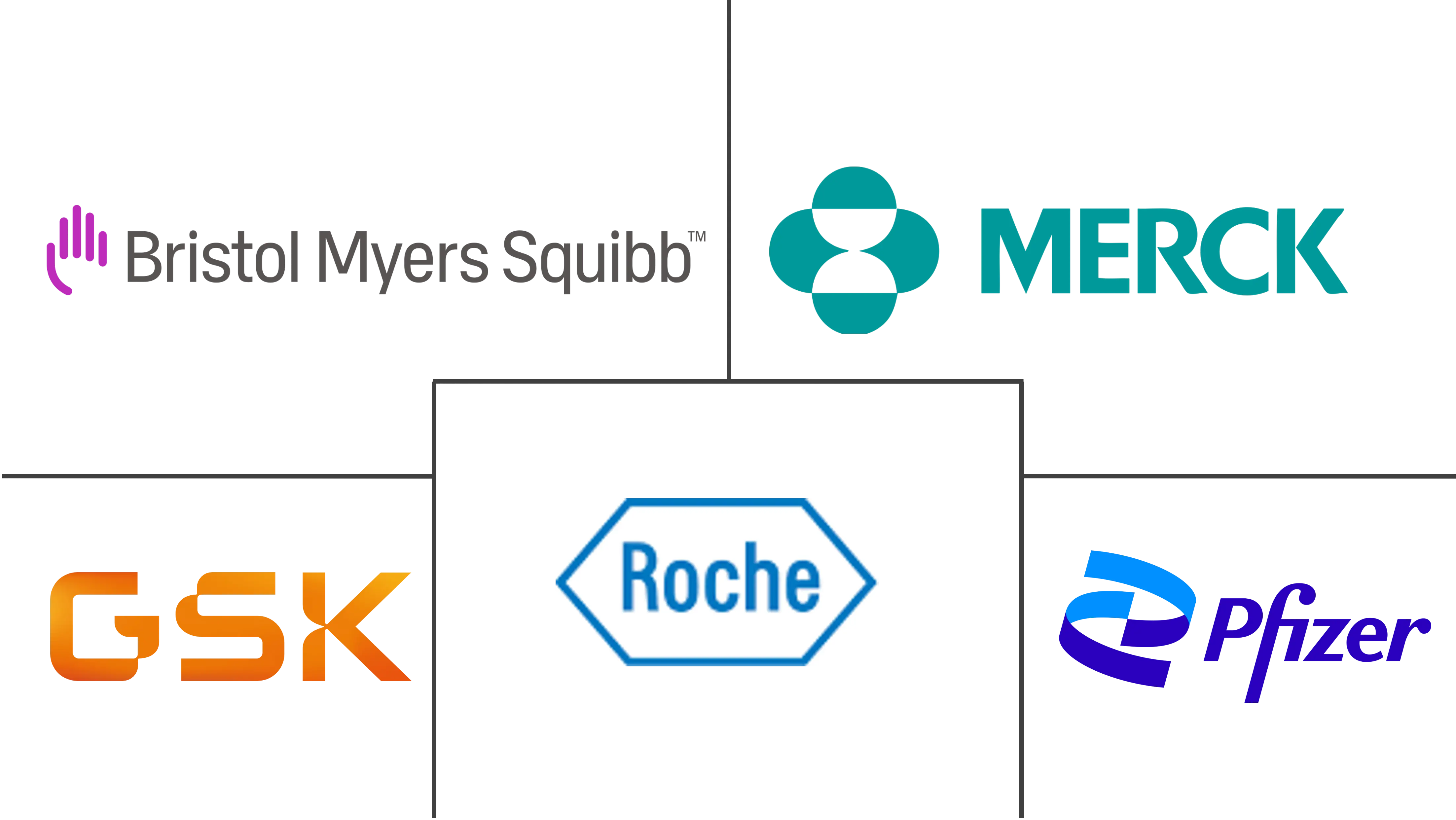
*Disclaimer: Major Players sorted in no particular order |
PD-1 and PD-L1 Inhibitors Market Analysis
The PD-1 and PD-L1 inhibitors market is estimated at USD 45.80 billion in 2023. It is expected to reach USD 104.59 billion by 2028, with a CAGR of 17.96% during the forecast period.
- The COVID-19 pandemic has caused widespread disruption in cancer care, including delays in diagnosis and treatment, as well as the suspension of clinical trials in the initial phase of the pandemic. For instance, according to the article published in the National Library of Medicine in June 2022, there was a decrease or delay in oncologic surgical procedures, cancer screening tests, and clinic visits and a significant decline in newly identified patients with cancer in the initial phase of the pandemic. As PD-1 and PD-L1 inhibitors are used explicitly in cancer treatments, the market growth witnessed a slight decline amid the outbreak. Additionally, delay, withdrawal, and decline of FDA approval for the PD-1 and PD-L1 drug therapy also impacted the studied market. For instance, in July 2022, BeiGene reported the delay in new PD-1 cancer immunotherapies, tislelizumab, in previously treated oesophageal squamous cell carcinoma (ESCC). The FDA solely mentioned COVID-related travel limitations as the reason for the agency's inability to conduct inspections in China. Delays in drug approval and site inspection by the FDA, a decline in clinical research, and delayed cancer treatment during COVID-19 all significantly impacted the market. However, with several government initiatives and research demonstrating the safety of PD-1 and PD-L1 inhibitor therapy in COVID-19 patients following immunization, the market gained notable pace in the latter phase of the pandemic and is likely to continue this trend over the coming years, as per the analysis.
- Factors such as rising investments in research and development (R&D), clinical trials by bio-pharmaceutical industries, growth in initiatives by the regulatory authorities for speedy approvals, and the growing burden of different cancers are anticipated to fuel the overall studied market growth. Several companies and research institutions have been focused on developing new PD-1 inhibitors to treat various cancers. For instance, in March 2022, Jacobio reported an RMB 421 million (USD 5.89 million) R&D expenditure, representing an 83% increase over 2021. The company concluded the phase I clinical investigation of AB-3312, and the recommended dose of monotherapy and combination therapy with PD-1 inhibitor has been determined. This surge in trials highlights the growth in research and development activities in the PD-1 and PD-L1 inhibitors market space, signifying a robust pipeline of therapies and encouraging further exploration of novel therapeutic approaches, boosting the market growth.
- The increasing cases of cancer across the globe are one of the major factors bolstering the market growth over the forecast period. For instance, as per the report published by the WHO in February 2022, around 400,000 children develop cancer each year, and the common type of cancer varies country-wise. Similarly, as per the report published by the American Cancer Society in January 2023, around 1.9 million people are expected to suffer from cancer in the United States by the end of 2023. A protein found in T cells (immune cells) helps manage the body's immune responses. When PD-1 binds to another protein called PD-L1, it helps to prevent T cells from killing other cells, including cancer cells. Therefore, increasing cancer cases are anticipated to propel the demand for PD-1 and PD-L1 inhibitors owing to their promising outcomes, thereby surging the market growth over the forecast period.
- Moreover, several approvals and clinical trial activities by key players are expected to boost the market's growth. For instance, in February 2023, the China National Medical Products Administration (NMPA) approved BeiGene's PD-1 inhibitor, tislelizumab, in combination with fluoropyrimidine and platinum chemotherapy, for the first-line treatment of patients with locally advanced unresectable or metastatic G/GEJ adenocarcinoma with high PD-L1 expression. Similarly, in November 2022, the FDA approved cemiplimab in combination with platinum-based chemotherapy as first-line therapy in adult patients with advanced NSCLC harboring no EGFR, ALK, or ROS1 mutations. In addition, as of June 2023, nearly 841 clinical trials were registered for PD-1 inhibitors and 606 clinical trials for PD-L1 inhibitors for cancer. Thus, with the growing number of product approvals and clinical trials, the market is expected to grow considerably over the forecast period.
- Hence, increasing research and development activities coupled with a growing number of cancer cases and drug approvals are expected to boost the market growth over the forecast period. However, the high risk of complications associated with the highly expensive oncology treatment and challenges in development with uncertainty in the regulatory process and high costs of clinical trials are likely to restrain the market growth over the forecast period.
PD-1 and PD-L1 Inhibitors Market Trends
PD-1 Inhibitors Segment is Expected to Witness Significant Growth Over the Forecast Period
- PD-1 (programmed cell death protein 1) inhibitors are a class of immunotherapy drugs used to treat cancer. PD-1 is a protein found on the surface of specific immune cells called T cells. It helps regulate the immune response by inhibiting T cells from attacking normal cells in the body. PD-1 inhibitors have shown significant clinical benefits in several types of cancer and have revolutionized the treatment landscape, particularly for patients with advanced or metastatic disease. They can induce durable responses and have demonstrated improved overall survival rates compared to traditional chemotherapy in some cases.
- Some well-known benefits of PD-1 inhibitors include enhanced immune response, improved survival rate, reduced toxicity, and potential long-lasting response. PD-1 inhibitors can be combined with other cancer treatments, such as chemotherapy, radiation therapy, targeted therapy, or other immunotherapies. Combinations of PD-1 inhibitors with other agents have shown synergistic effects, leading to improved response rates and patient outcomes. PD-1 inhibitors have been approved for treating multiple types of cancer, including melanoma, non-small cell lung cancer, renal cell carcinoma, classical Hodgkin lymphoma, urothelial carcinoma, and others. Some of the commonly used PD-1 inhibitors are Pembrolizumab (Keytruda), Nivolumab (Opdivo), and Cemiplimab (Libtayo), among others.
- A study published in ASH publications in November 2022 disclosed the results of an open-label phase 1/2 study of Favezelimab (anti-LAG-3) Plus Pembrolizumab in relapsed or refractory classical Hodgkin lymphoma (cHL) after anti-PD-1 treatment. As per the study, heavily pretreated patients with R/R cHL whose disease progressed after anti-PD-1 therapy showed effective antitumor activity and tolerable safety. Additionally, according to new clinical study results published by the National Institute of Health in August 2022, it was found that adding the immunotherapy medicine pembrolizumab (Keytruda) to chemotherapy can help certain patients with advanced triple-negative breast cancer live longer than if they only got chemotherapy. Such research and development supporting PD-1 inhibitor therapies are anticipated to drive overall market growth.
- Furthermore, significant new drug launches in the PD-1 inhibitors space have been a fuelling factor for the segment's growth. For instance, in January 2023, the Food and Drug Administration (FDA) approved KEYTRUDA (pembrolizumab) as adjuvant treatment following surgical resection and platinum-based chemotherapy for patients with Stage IB, II, or IIIA Non-Small Cell Lung Cancer (NSCLC).
- Therefore, with the benefits associated with PD-1 inhibitors and the new launches, the segment is expected to witness robust growth over the forecast period.
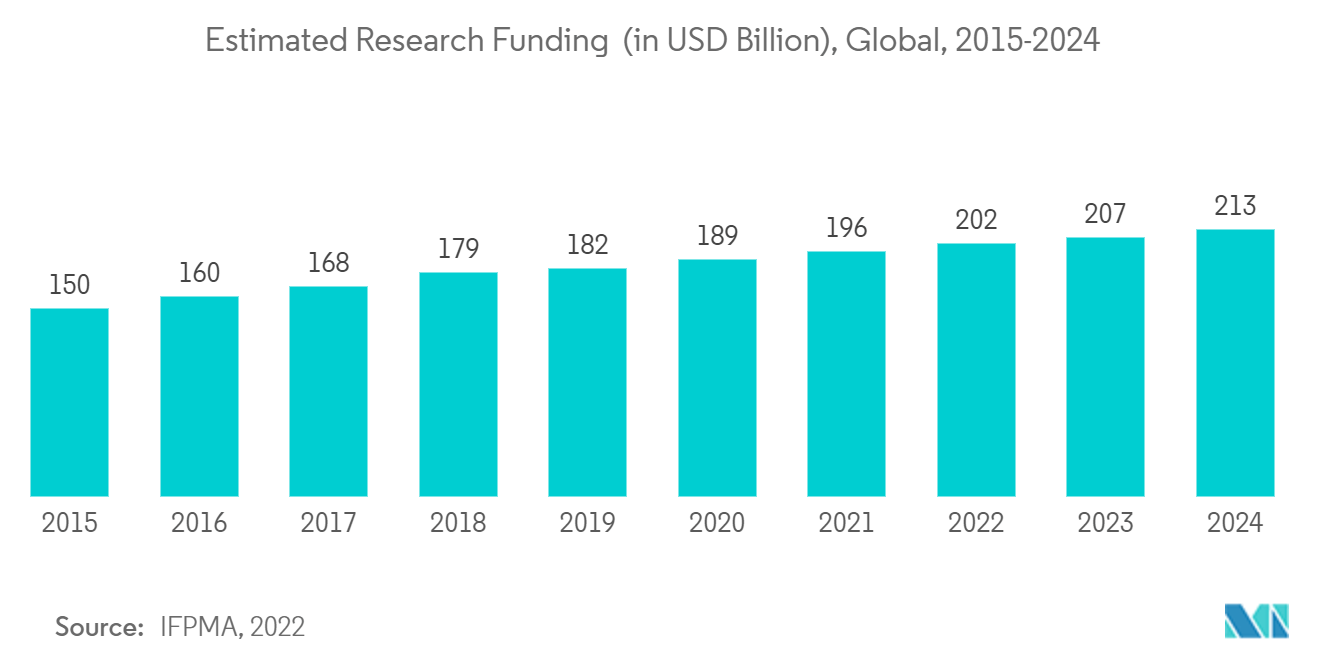
North American is Expected to Hold a Significant Market Share during the Forecast Period
- North America is expected to grow significantly in the PD-1 and PD-L1 inhibitors market over the forecast period due to the growing prevalence of various cancer cases, such as skin cancer, urothelial carcinomas, and lung cancers, in the United States, Canada, and Mexico, among other countries in the region. Additionally, product launches and investments are the other factors that drive the overall market's growth in the region.
- The growing burden of cancer in the United States is expected to boost the demand for PD-1 and PD-L1 inhibitors, thereby boosting regional market growth. For instance, according to the statistics published by the American Cancer Society (ACS) in 2023, the estimated incidence of cancer cases increased from 1.91 million in 2021 to 1.96 million in 2023, an increase of more than 60 thousand cases in just two years, demonstrating a rapid growth in the cancer cases within the country.
- Furthermore, increasing investment in cancer research is one of the key factors in market growth. For instance, the Consolidated Appropriations Act 2022 allocated nearly USD 6,900 million to the National Cancer Institute (NCI), a USD 353 million net increase over FY2021. The Cancer Moonshot received USD 194 million in funding in FY2022, and the Childhood Cancer Data Initiative received USD 50 million. The allocation of USD 6.9 billion to the National Cancer Institute (NCI) allows for more research and development activities, leading to advancements in understanding the mechanisms and developing more effective inhibitory mechanisms. The Cancer Moonshot and Childhood Cancer Data Initiative funding supports research and clinical trials, which can result in expanded indications and regulatory approvals. Ultimately, this is expected to increase the investment and patient access to PD-1 and PD-L1 inhibitors, fostering market growth during the analysis period.
- Moreover, increasing product launches in the region is expected to increase the availability of the drugs, thereby boosting market growth. For instance, in March 2023, the US FDA approved Zynyz(retifanlimab-dlwr), a humanized monoclonal antibody targeting programmed death receptor-1 (PD-1), for the treatment of adults with metastatic or recurrent locally advanced Merkel cell carcinoma (MCC). Similarly, in September 2022, the US-FDA approved durvalumab (Imfinzi, AstraZeneca UK Limited) in combination with gemcitabine and cisplatin for adult patients with locally advanced or metastatic biliary tract cancer (BTC). Thus, owing to the rising R&D and the presence of better healthcare infrastructure, along with the high prevalence of cancer in the region, the market is expected to witness a significant growth rate over the forecast period.
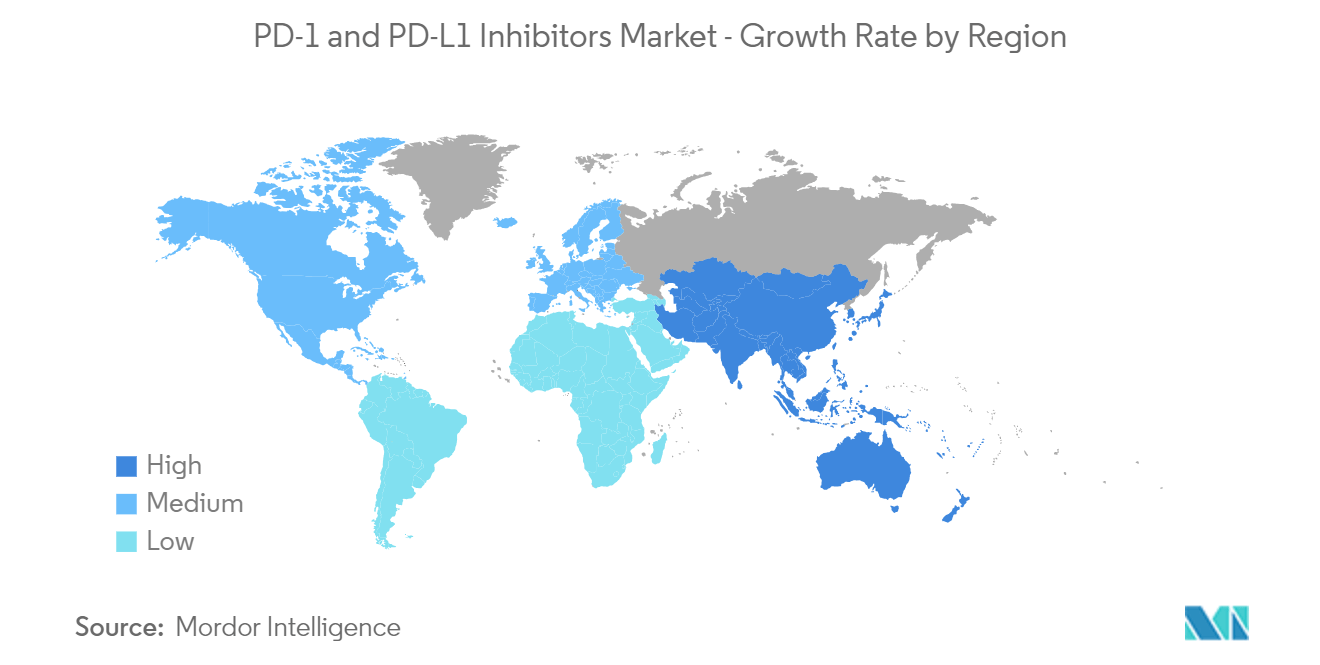
PD-1 and PD-L1 Inhibitors Industry Overview
The PD-1 and PD-L1 inhibitors market is consolidated and consists of prominent market players. Some companies are expanding their market position by adopting various strategies such as acquisitions, mergers, and research collaboration, while others are investing in clinical trials to extend the treatment of other indications with the existing drugs to address the unmet challenges of the disease burden driving the market share. Some of the key market players in the PD-1 and PD-L1 inhibitors market are Bristol-Myers Squibb Company, Merck and Co., AstraZeneca PLC, Pfizer Inc., GlaxoSmithKline PLC, and F. Hoffmann-La Roche AG among others.
PD-1 and PD-L1 Inhibitors Market Leaders
-
Bristol-Myers Squibb Company
-
Merck & Co.
-
F. Hoffmann-La Roche AG
-
Pfizer Inc.
-
GSK plc
*Disclaimer: Major Players sorted in no particular order
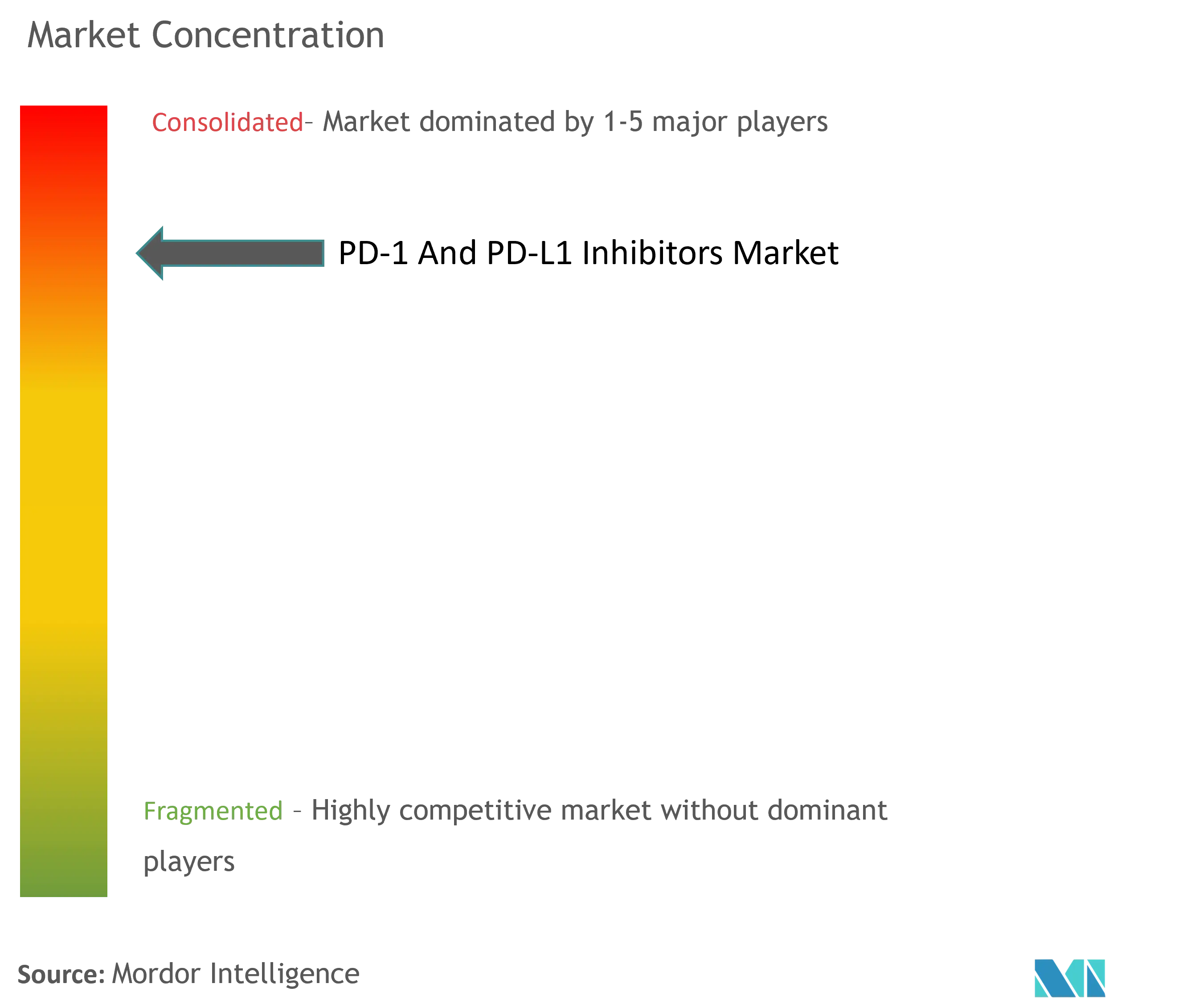
PD-1 and PD-L1 Inhibitors Market News
- March 2023: Ono Pharmaceutical Co., Ltd. received supplemental approval for Opdivo (nivolumab) Intravenous Infusion, a human anti-human PD-1 monoclonal antibody in Japan for the neoadjuvant treatment of non-small cell lung cancer in combination with chemotherapy.
- January 2023:The FDA approved KEYTRUDA (pembrolizumab) as adjuvant treatment following surgical resection and platinum-based chemotherapy for patients with Stage IB, II, or IIIA Non-Small Cell Lung Cancer (NSCLC).
PD-1 and PD-L1 Inhibitors Market Report - Table of Contents
1. INTRODUCTION
- 1.1 Study Assumptions and Market Definition
- 1.2 Scope of the Study
2. RESEARCH METHODOLOGY
3. EXECUTIVE SUMMARY
4. MARKET DYNAMICS
- 4.1 Market Overview
-
4.2 Market Drivers
- 4.2.1 Rising Investments in R&D and Clinical Trials by Bio-pharmaceutical Industries
- 4.2.2 Increased Encouragement Initiatives by the Regulatory Authorities with Favorable Approvals and Special Designations
- 4.2.3 Growing Burden of Different Cancers
-
4.3 Market Restraints
- 4.3.1 Risk of Complications Associated with the Highly Expensive Oncology Treatment
- 4.3.2 Challenges in Development with Uncertainty in Regulatory Process and High Costs of Tedious Clinical Trials
-
4.4 Porter's Five Forces Analysis
- 4.4.1 Threat of New Entrants
- 4.4.2 Bargaining Power of Buyers/Consumers
- 4.4.3 Bargaining Power of Suppliers
- 4.4.4 Threat of Substitute Products
- 4.4.5 Intensity of Competitive Rivalry
5. MARKET SEGMENTATION (Market Size by Value - USD)
-
5.1 By Type of Inhibitors
- 5.1.1 PD-1 Inhibitors
- 5.1.2 PD-L1 Inhibitors
-
5.2 By Application
- 5.2.1 Hodgkin Lymphoma
- 5.2.2 Kidney Cancer
- 5.2.3 Melanoma
- 5.2.4 Non-small Cell Lung Cancer
- 5.2.5 Other Applications
-
5.3 By Distribution Channel
- 5.3.1 Hospital Pharmacies
- 5.3.2 Retail Pharmacies
- 5.3.3 Online Pharmacies
-
5.4 Geography
- 5.4.1 North America
- 5.4.1.1 United states
- 5.4.1.2 Canada
- 5.4.1.3 Mexico
- 5.4.2 Europe
- 5.4.2.1 Germany
- 5.4.2.2 United Kingdom
- 5.4.2.3 France
- 5.4.2.4 Italy
- 5.4.2.5 Spain
- 5.4.2.6 Rest of Europe
- 5.4.3 Asia-Pacific
- 5.4.3.1 China
- 5.4.3.2 Japan
- 5.4.3.3 India
- 5.4.3.4 Australia
- 5.4.3.5 South Korea
- 5.4.3.6 Rest of Asia-Pacific
- 5.4.4 Middle East and Africa
- 5.4.4.1 GCC
- 5.4.4.2 South Africa
- 5.4.4.3 Rest of Middle East and Africa
- 5.4.5 South America
- 5.4.5.1 Brazil
- 5.4.5.2 Argentina
- 5.4.5.3 Rest of South America
6. COMPETITIVE LANDSCAPE
-
6.1 Company Profiles
- 6.1.1 Bristol-Myers Squibb Company
- 6.1.2 Merck & Co.
- 6.1.3 F. Hoffmann-La Roche AG
- 6.1.4 GlaxoSmithKline PLC
- 6.1.5 Amgen Inc.
- 6.1.6 Eli Lilly and Company
- 6.1.7 AstraZeneca PLC
- 6.1.8 BeiGene LTD
- 6.1.9 Pfizer Inc.
- 6.1.10 Regeneron Pharmaceuticals Inc.
- *List Not Exhaustive
7. MARKET OPPORTUNITIES AND FUTURE TRENDS
** Subject To AvailablityPD-1 and PD-L1 Inhibitors Industry Segmentation
As per the scope of the report, programmed cell death protein 1 (PD-1) inhibitors and programmed cell death ligand 1 (PD-L1) inhibitors are a group of new checkpoint inhibitor anticancer drugs that block the activity of PD-1 and PDL1 immune checkpoint proteins present in the surface of cells. These immune checkpoint inhibitors are also active in pregnancy following tissue allografts and emerging as a front-line treatment in immunotherapy for several types of cancer. An indication of specific staining interpretation defines tumor PD-L1 status.
The PD-1 and PD-L1 inhibitors market is segmented by inhibitors (PD-1 inhibitors and PD-L1 inhibitors), application (Hodgkin lymphoma, kidney cancer, melanoma, non-small cell lung cancer, and other applications), distribution channel (hospital pharmacies, retail pharmacies, and online pharmacies), and geography (North America, Europe, Asia-Pacific, Middle East, and Africa, and South America). The market report also covers the estimated market sizes and trends for 17 different countries across major regions globally.
The report offers the value (in USD) for the above segments.
| By Type of Inhibitors | PD-1 Inhibitors | |
| PD-L1 Inhibitors | ||
| By Application | Hodgkin Lymphoma | |
| Kidney Cancer | ||
| Melanoma | ||
| Non-small Cell Lung Cancer | ||
| Other Applications | ||
| By Distribution Channel | Hospital Pharmacies | |
| Retail Pharmacies | ||
| Online Pharmacies | ||
| Geography | North America | United states |
| Canada | ||
| Mexico | ||
| Geography | Europe | Germany |
| United Kingdom | ||
| France | ||
| Italy | ||
| Spain | ||
| Rest of Europe | ||
| Geography | Asia-Pacific | China |
| Japan | ||
| India | ||
| Australia | ||
| South Korea | ||
| Rest of Asia-Pacific | ||
| Geography | Middle East and Africa | GCC |
| South Africa | ||
| Rest of Middle East and Africa | ||
| Geography | South America | Brazil |
| Argentina | ||
| Rest of South America |
PD-1 and PD-L1 Inhibitors Market Research FAQs
What is the current Global PD-1 and PD-L1 Inhibitors Market size?
The Global PD-1 and PD-L1 Inhibitors Market is projected to register a CAGR of 17.96% during the forecast period (2024-2029)
Who are the key players in Global PD-1 and PD-L1 Inhibitors Market?
Bristol-Myers Squibb Company, Merck & Co., F. Hoffmann-La Roche AG, Pfizer Inc. and GSK plc are the major companies operating in the Global PD-1 and PD-L1 Inhibitors Market.
Which is the fastest growing region in Global PD-1 and PD-L1 Inhibitors Market?
Asia Pacific is estimated to grow at the highest CAGR over the forecast period (2024-2029).
Which region has the biggest share in Global PD-1 and PD-L1 Inhibitors Market?
In 2024, the North America accounts for the largest market share in Global PD-1 and PD-L1 Inhibitors Market.
What years does this Global PD-1 and PD-L1 Inhibitors Market cover?
The report covers the Global PD-1 and PD-L1 Inhibitors Market historical market size for years: 2019, 2020, 2021, 2022 and 2023. The report also forecasts the Global PD-1 and PD-L1 Inhibitors Market size for years: 2024, 2025, 2026, 2027, 2028 and 2029.
PD-1 and PD-L1 Inhibitors Industry Report
Statistics for the 2024 PD-1 and PD-L1 Inhibitors market share, size and revenue growth rate, created by Mordor Intelligence™ Industry Reports. PD-1 and PD-L1 Inhibitors analysis includes a market forecast outlook 2029 and historical overview. Get a sample of this industry analysis as a free report PDF download.



